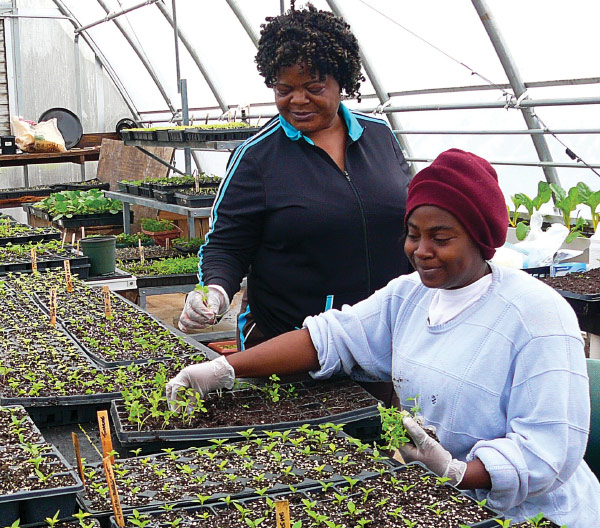New Entry and Beginning Farmers
 |
|
Trainees learn seedling production. Photo provided by Yao Afantchao. |
I recently came across a drugstore newsstand with an issue of a magazine called New Pioneer. The cover photograph showed a family standing in front of a tidy wooden shack with solar panels on the roof. The husband, wife, and children were surrounded by chickens, and nearby was a young calf. The headlines promised stories such as “Basketweave for profit,” “Mini-farming,” and “Raising livestock.” One thing’s for sure: the editors of New Pioneer have put their finger on the pulse of a new back-to-basics movement, one that would be understood by today’s connected, savvy, environmentally-conscious, new and beginning farmer.
The USDA defines beginning farmers as those who have operated a farm for ten years or less. Unfortunately, this definition doesn’t take us very far in understanding the beginning farmer.
Indeed, people who feel the allure and desire to become a farmer come from all walks of society, every education and income level. The back-to-the-land movement has deep roots, and persists even today. Of course, beginning farmers nowadays may look up information about weather and pest conditions on a smart phone and deliver their produce to a trendy farmer’s market in the suburbs or city. Some aspects of being a beginning farmer are as innovative as Apple’s latest iPhone. And some ideas are as old as the rain falling on the soil and nurturing seeds to grow into plants that bear fruit. For as long as humans live, we will need food grown from the land.
In this issue, we write about the theme “new entry and beginning farmers and IPM.” We invited authors to contribute pieces related to this theme, their work and interest, and IPM development and adoption. We selected the authors because of their expertise and connection with the Northeastern IPM Center. We believe all who read this information-packed issue of IPM Insights will expand their understanding.
We selected pieces from the following four authors:
Jennifer Hashley, of Tufts University, is working on a Center grant on training diverse IPM practitioners, in her second year.
Ana Legrand, of the University of Connecticut, works with immigrants and has received funding to develop and conduct training programs.
Yao Afantchao, of the University of the District of Columbia, directs a sustainability research farm and serves on the Northeastern IPM Center Advisory Council.
Rose Ogutu, of Delaware State University, is a passionate advocate for IPM education and training and serves on our Advisory Council as well.
The beginning farmer can find much good information that is freely available on the web. The Cornell Small Farms Program maintains a list of tutorials and worksheets to guide new farmers writing a business plan; videos of experienced farmers giving advice and up-close production techniques; and a map pointing to various farm service providers.
(http://neipmc.org/go/PWGe).
The University of Maryland offers an entire guidebook and website on beginning farming. The guidebook contains various publications often requested by beginning farmers, covering farm establishment, equipment, enterprise selection, marketing, and business planning.
(http://neipmc.org/go/DhFh).
Iowa State University has a Beginning Farmer Center. The Center transitions the operations of retiring farmers to the next generation of beginning farmers and provides advice to new farmers.
(http://neipmc.org/go/hEPf).
All of this information, of course, will help you get your farming operation established. But what happens when another very old problem happens—the pests come? We dedicate this issue to beginning farmers and present articles from four experts to enlighten us. Read on.
— by CHRIS GONZALES
The Northeastern IPM Center promotes integrated pest management for reducing risks to human health and the environment. If republishing our news, please acknowledge the source (“From Northeast IPM Insights”) along with a link to our website.
